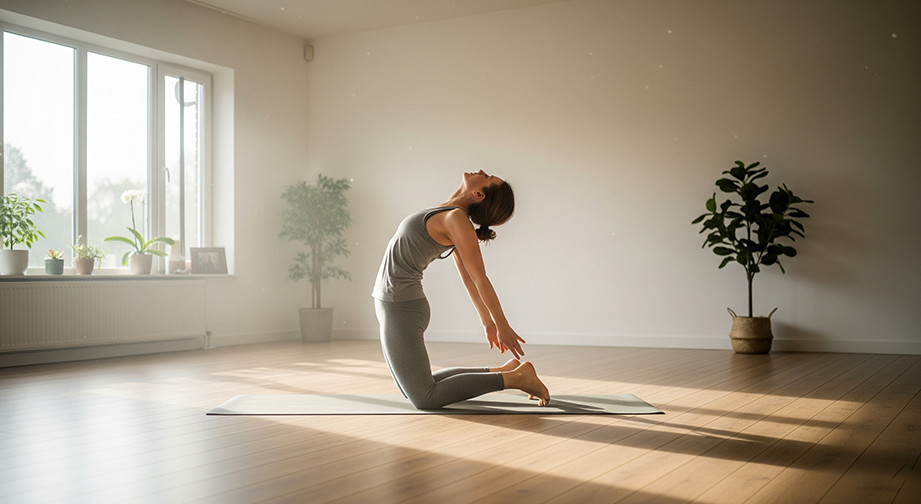Ushtrasana (Camel Pose) – A Complete, Beginner-Friendly Guide
Introduction
Ushtrasana, or Camel Pose, is a classic kneeling yoga backbend that opens up your chest and increases spine flexibility. In Sanskrit, “Ushtra” means camel, and “asana” means posture or pose — together, Ushtrasana symbolizes the strong, yet gentle, nature of the camel.
Essence: This posture is known for its energizing and deeply heart-opening effects.
Relatable hook: If you often feel stiff after hours at your desk or hunched forward, Camel Pose is your new go-to move to reclaim space, energy, and openness in your body.
Step-by-Step Guide: How to Practice Ushtrasana (Camel Pose)

- Begin on your knees. Place your knees hip-width apart on your mat. Keep your thighs perpendicular to the floor and rest the tops of your feet flat on the mat.
- Position your palms on your lower back. Fingers point down. This gives gentle support as you start.
- Inhale & lengthen your spine. Imagine lifting and lengthening upwards, keeping your chest broad.
- Exhale, gently press hips forward. Keep hips stacked above knees as you start to arch back slightly, still supporting with your hands.
- Inhale, open the chest. Begin to reach your hands back one at a time to your heels (if that’s accessible). Otherwise, keep hands on your lower back.
- Breathe evenly. Let your head drop back softly if it feels comfortable, or keep the neck neutral to avoid strain.
- Hold for 3–5 breaths (15–30 seconds). Stay connected to your breath, focusing on even inhales and exhales.
- To release: Inhale, gently bring your hands back to your lower back, slowly bring your torso upright, and rest in Child’s Pose for a few breaths.
- Rounds: Repeat for 2–3 rounds if comfortable.
- For beginners: Keep hands on lower back, or use yoga blocks beside heels.
- For advanced: Try deepening the backbend by pressing thighs forward, or reaching one or both hands to opposite ankles for a twist.
Alignment & Safety Tips
- Alignment cues: Keep hips directly over the knees (don’t let hips shift back). Chest lifts upward, not just backward.
- Engage thighs to keep stability. Press shins and feet down for grounding.
- Common mistakes: Collapsing the lower back (pelvis should not jut forward or over-arching lumbar), straining the neck, splaying knees too wide. Avoid these by using props and moving with awareness.
- Safety: Avoid Camel Pose if you’re pregnant, have recent back or neck injury, or experience chronic migraines. Always listen to your body!
Benefits of Ushtrasana (Camel Pose)
Physical Benefits
- Opens up the chest, shoulder, and hip flexors
- Improves spinal flexibility and posture
- Stretches abdominal muscles and front thighs
- Strengthens the back, especially lower and middle spine
Mental Benefits
- Reduces stress and tension
- Boosts energy and combats fatigue
- Helps develop focus and self-confidence
Energy & Chakra Connection
- Opens the Heart Chakra (Anahata) fostering emotional openness and compassion
- Invigorates whole energy body, combating sluggishness
Contraindications
- Pregnant women should avoid deep backbends, including Ushtrasana.
- If you have recent or chronic neck, back, or shoulder injuries, skip this pose.
- People with high or low blood pressure should practice with caution.
- Alternative: Try Sphinx Pose (Salamba Bhujangasana) for a gentler heart opener.
Beginner’s Tips & Variations
- Use props: Place yoga blocks beside the ankles to raise heels up for easier access.
- Wall support: Practice with thighs or hips touching the wall to safeguard alignment.
- Gentle variation: Keep hands on lower back or sacrum through the pose for extra support.
- Advanced variations: Deepen the stretch by reaching for opposite ankles or performing the pose with toes tucked under.
How to Include Ushtrasana in Your Yoga Flow
- Best practiced after warming up the body with gentle backbends (e.g., Cobra or Sphinx Pose).
- Use as a peak or main posture in your sequence for maximum effect.
- Follow with gentle counterposes like Child’s Pose (Balasana) or Seated Forward Fold (Paschimottanasana).
Mind-Body Connection
Move into Ushtrasana with awareness, letting your breath lead each movement. It’s a chance to tune into your emotional state—opening the heart physically and energetically. If you’re seeking more compassion and self-confidence, Camel Pose is a gentle nudge to open up to yourself and the world.
Heart Chakra Activation: This posture is believed to help you cultivate loving-kindness and release emotional blockages.
Summary Box
- Asana Name: Camel Pose (Ushtrasana)
- Level: Beginner to Intermediate
- Focus Areas: Chest, spine, thighs, hip flexors, shoulders
- Duration: Hold for 15–30 seconds (3–5 breaths), repeat 2–3 times
- Best Time to Practice: Morning or Early Evening
FAQs – Ushtrasana (Camel Pose)
Is Camel Pose safe for beginners?
Yes, with proper guidance and props, beginners can safely practice Ushtrasana. Always move slowly and use support if needed.
What should I do if I feel dizzy in this pose?
Come out of the pose immediately, sit or rest in Child’s Pose and breathe until comfortable. Avoid dropping your head back too far.
Can I practice Ushtrasana daily?
It’s best to include Camel Pose 2–3 times per week, not necessarily daily, especially if you’re new to backbending.